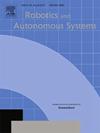A design procedure for a novel concept of shape-memory-alloy-actuated finger exoskeleton
IF 4.3
2区 计算机科学
Q1 AUTOMATION & CONTROL SYSTEMS
引用次数: 0
Abstract
This paper provides a thorough investigation demonstrating the feasibility of an innovative finger exoskeleton design concept in a compact, self-contained shape using Shape Memory Alloy (SMA) wires. This novel design integrates SMA wires directly onto the finger body, eliminating the need for bulky wrist actuators. Strategically positioned, the SMA wires serve as both actuators and sensors. The proposed exoskeleton can be used for rehabilitation purposes or for hand augmentation during manufacturing tasks. To properly design the exoskeleton, multiple simulation models have been developed. Kinematic and dynamic analyses were conducted to determine the sufficient motion ranges and forces as a function of SMA wire locations. Both models and experiments confirm the feasibility of integrating SMA wires within the limited space near the fingers. Several experimental tests were conducted to validate the simulation model results. Moreover, thermal-camera measurements confirm that SMA wires can be safely isolated and attached to the finger, preventing skin overheating. All simulation and experimental outcomes indicate the reliability of the proposed design procedure and the engineering feasibility of our novel finger.
形状记忆合金驱动手指外骨骼新概念的设计过程
本文提供了一项深入的研究,展示了一种创新的手指外骨骼设计概念的可行性,该设计概念采用形状记忆合金(SMA)导线,具有紧凑、独立的形状。这种新颖的设计将SMA导线直接集成到手指体上,消除了对笨重的手腕执行器的需求。战略性定位,SMA导线作为执行器和传感器。拟议的外骨骼可用于康复目的或在制造任务期间用于手部增强。为了合理设计外骨骼,开发了多种仿真模型。进行了运动学和动力学分析,以确定足够的运动范围和力作为SMA钢丝位置的函数。模型和实验都证实了在手指附近有限空间内集成SMA导线的可行性。通过实验验证了仿真模型的正确性。此外,热成像测量证实,SMA导线可以安全地隔离并连接到手指上,防止皮肤过热。所有的仿真和实验结果都表明了所提出的设计程序的可靠性和我们的新型手指的工程可行性。
本文章由计算机程序翻译,如有差异,请以英文原文为准。
求助全文
约1分钟内获得全文
求助全文
来源期刊

Robotics and Autonomous Systems
工程技术-机器人学
CiteScore
9.00
自引率
7.00%
发文量
164
审稿时长
4.5 months
期刊介绍:
Robotics and Autonomous Systems will carry articles describing fundamental developments in the field of robotics, with special emphasis on autonomous systems. An important goal of this journal is to extend the state of the art in both symbolic and sensory based robot control and learning in the context of autonomous systems.
Robotics and Autonomous Systems will carry articles on the theoretical, computational and experimental aspects of autonomous systems, or modules of such systems.
 求助内容:
求助内容: 应助结果提醒方式:
应助结果提醒方式:


